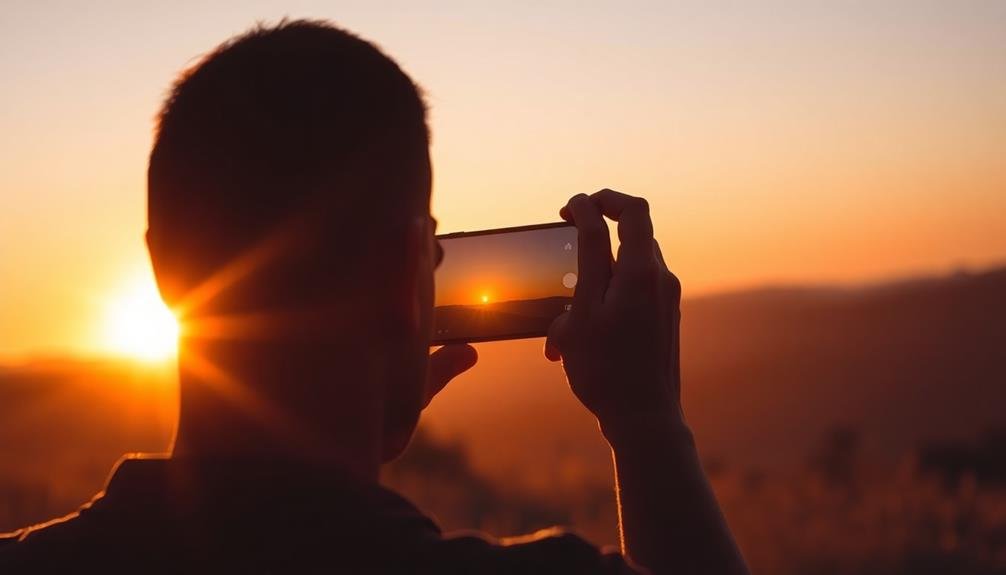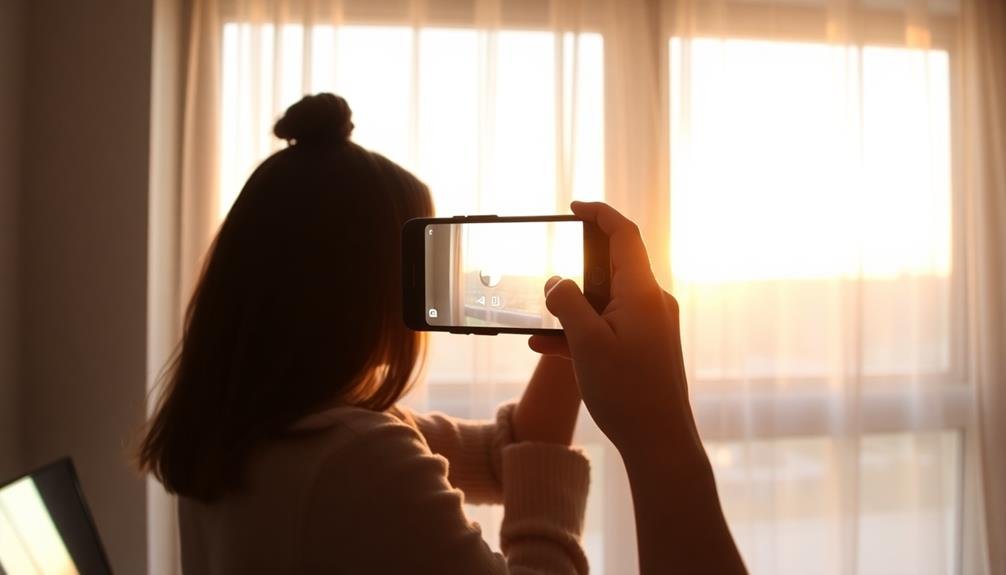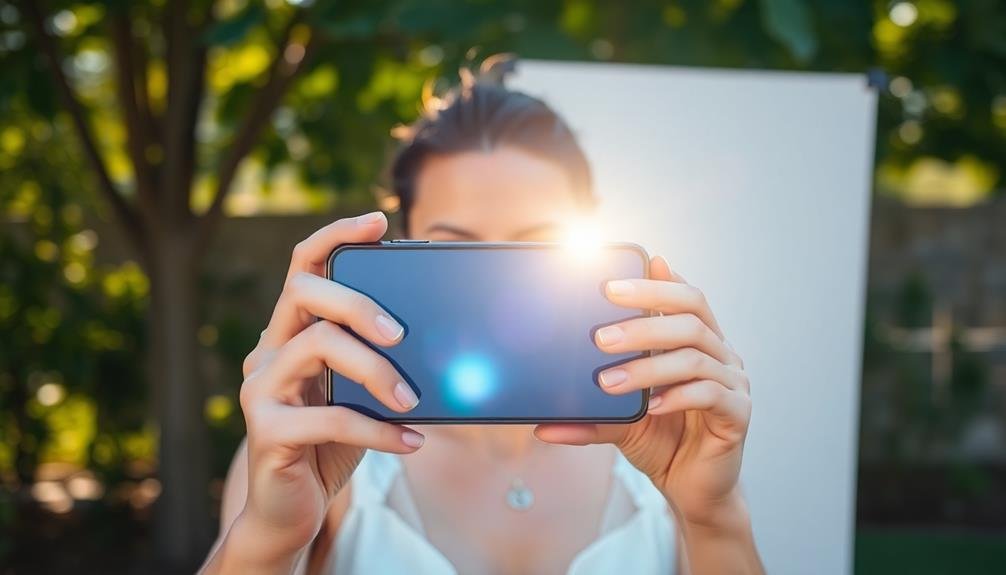Harness the power of natural light to transform your smartphone photos with these three game-changing hacks. First, capture the golden hour's warm, soft glow just after sunrise or before sunset for stunning portraits and landscapes. Next, use windows as natural softboxes to create beautifully diffused light for indoor shots. Finally, experiment with everyday reflectors like white cardboard or aluminum foil to bounce light and fill in shadows. Position your subject facing the light source for flattering illumination, or try backlighting for dramatic silhouettes. By mastering these techniques, you'll reveal a world of creative possibilities for your smartphone photography.
Golden Hour Magic

The golden hour, nature's lighting masterpiece, offers unparalleled opportunities for stunning smartphone photos. This magical time occurs twice daily, just after sunrise and before sunset, when the sun is low on the horizon. During these periods, the light is soft, warm, and diffused, creating a flattering glow that enhances your subjects.
To make the most of golden hour, plan ahead. Check the sunset and sunrise times for your location and arrive early to set up your shots. Position your subjects facing the sun to capture the warm, golden tones on their faces. Alternatively, shoot with the sun behind them for a beautiful backlit effect or dreamy silhouettes.
Experiment with different angles and compositions. Try capturing lens flares by partially obscuring the sun behind objects. Use the long shadows cast during this time to add depth and drama to your images.
Don't forget to adjust your smartphone's exposure settings to prevent overexposure of bright areas. If your phone has a "portrait" or "pro" mode, use it to fine-tune your shots and achieve professional-looking results.
Window Light Mastery

While golden hour offers fleeting moments of perfect light, window light provides a versatile and accessible option for stunning smartphone photos throughout the day.
You'll find that windows act as natural softboxes, diffusing harsh sunlight and creating a flattering glow for your subjects. To master window light, position your subject facing or at a 45-degree angle to the window, allowing the light to illuminate their features evenly.
For dramatic portraits, try backlighting your subject by placing them between the window and your camera. This technique creates a beautiful rim light effect, adding depth and dimension to your images.
Don't forget to adjust your camera's exposure to properly capture the subject's face.
Here are four tips to enhance your window light photography:
- Use sheer curtains to soften harsh sunlight
- Experiment with different times of day for varied light intensity
- Utilize reflectors or white boards to fill in shadows
- Try shooting from different angles relative to the window
Reflector Techniques

Beyond window light, reflectors offer a powerful tool for manipulating natural light in your smartphone photography. You don't need expensive equipment; everyday items can serve as effective reflectors. White cardboard, aluminum foil, or even a white t-shirt can bounce light onto your subject, filling in shadows and creating a more balanced exposure.
To use a reflector, position it opposite your main light source. If the sun's to your left, place the reflector on the right. Experiment with different angles to control the intensity and direction of the reflected light. For a softer effect, move the reflector farther from your subject; for stronger light, bring it closer.
Reflectors aren't just for brightening shadows. Use a gold-toned reflector to add warmth to your photos or a silver one for a cooler, more dramatic look. You can even use black surfaces to absorb light and create deeper shadows for a moodier atmosphere.
Don't limit yourself to flat reflectors. Curved surfaces can focus light more intensely on specific areas. Try using a curved piece of cardboard or a flexible reflector to direct light precisely where you want it.
Frequently Asked Questions
How Can I Reduce Harsh Shadows in Outdoor Smartphone Photos?
To reduce harsh shadows in outdoor smartphone photos, you'll want to soften the light. Try using a reflector or white cloth to bounce light onto shadowy areas. You can also move to a shaded spot for more even lighting.
What's the Best Way to Capture Natural Light in Low-Light Indoor Settings?
You'll capture better low-light indoor photos by positioning yourself near windows. Use a tripod or steady surface to minimize shake. Increase ISO cautiously, and try night mode if available. Don't forget to clean your lens for clarity.
Are There Any Smartphone Apps That Help Optimize Natural Light Photography?
You'll find several apps to enhance natural light photography. Try VSCO, Snapseed, or ProCamera for advanced controls. They offer features like exposure adjustment, white balance tweaking, and HDR modes to optimize your naturally lit shots.
How Do I Adjust White Balance for Accurate Colors in Natural Light?
You can adjust white balance by using your camera app's manual settings. Look for a white balance option and choose presets like "daylight" or "cloudy." You'll also find a color temperature slider to fine-tune your adjustments for accurate colors.
Can I Use Natural Light Effectively for Smartphone Video Recording?
You can absolutely use natural light for smartphone video! Position yourself facing a window for even illumination. Avoid harsh shadows by using sheer curtains. If you're outside, seek soft, diffused light for the best results.
In Summary
You've now got three powerful tools to elevate your smartphone photography using natural light. Embrace the golden hour's warm glow, master the art of window light, and harness the power of reflectors. With these techniques, you'll transform ordinary scenes into extraordinary images. Remember, great photography isn't just about equipment—it's about understanding and utilizing light. So get out there, experiment with these hacks, and watch your photos come to life. Happy shooting!





Leave a Reply